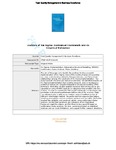Enablers of Six Sigma: contextual framework and its empirical validation
| dc.contributor.author | Dubey, R | |
| dc.contributor.author | Gunasekaran, A | |
| dc.contributor.author | Childe, Stephen J | |
| dc.contributor.author | Fosso Wamba, S | |
| dc.contributor.author | Papadopoulos, T | |
| dc.date.accessioned | 2016-10-03T09:23:53Z | |
| dc.date.available | 2016-10-03T09:23:53Z | |
| dc.date.issued | 2015-08-21 | |
| dc.identifier.issn | 1478-3363 | |
| dc.identifier.issn | 1478-3371 | |
| dc.identifier.uri | http://hdl.handle.net/10026.1/5542 | |
| dc.description.abstract |
The aim of the paper is to identify the enablers for the successful implementation of Six Sigma. None of the existing frameworks provides any clear understanding related to linkages between, and hierarchical relationships among, the constructs of Six Sigma implementation. Our study has both inductive and deductive elements. We identified enablers of Six Sigma implementation from existing research, and we developed a contextual framework using the interpretive structural modelling technique. We further studied enablers based on their driving power and dependence using MICMAC analysis to categorise the enablers into four clusters. In order to validate the ISM model statistically we developed and pre-tested a structured questionnaire before using it for a survey. Data were collected using a split survey method using a modified version of Dillman's total design method. We performed non-response bias before checking assumptions such as constant variance and normality. We further checked the reliability and construct validity using confirmatory factor analysis. We find that constructs and indicators of our theoretical framework meet the criteria, and find them to be a good fit based on confirmatory factor analysis. We draw conclusions based on statistical analyses and our study limitations, and suggest further research directions. | |
| dc.format.extent | 1-27 | |
| dc.language | en | |
| dc.language.iso | en | |
| dc.publisher | Informa UK Limited | |
| dc.subject | Six Sigma | |
| dc.subject | implementation | |
| dc.subject | interpretive structural modelling | |
| dc.subject | MICMAC | |
| dc.subject | confirmatory factor analysis | |
| dc.subject | theory building | |
| dc.title | Enablers of Six Sigma: contextual framework and its empirical validation | |
| dc.type | journal-article | |
| dc.type | Journal Article | |
| plymouth.author-url | https://www.webofscience.com/api/gateway?GWVersion=2&SrcApp=PARTNER_APP&SrcAuth=LinksAMR&KeyUT=WOS:000386651100009&DestLinkType=FullRecord&DestApp=ALL_WOS&UsrCustomerID=11bb513d99f797142bcfeffcc58ea008 | |
| plymouth.issue | 11-12 | |
| plymouth.volume | 27 | |
| plymouth.publication-status | Published | |
| plymouth.journal | Total Quality Management & Business Excellence | |
| dc.identifier.doi | 10.1080/14783363.2015.1075877 | |
| plymouth.organisational-group | /Plymouth | |
| plymouth.organisational-group | /Plymouth/Faculty of Arts, Humanities and Business | |
| plymouth.organisational-group | /Plymouth/Faculty of Arts, Humanities and Business/Plymouth Business School | |
| plymouth.organisational-group | /Plymouth/REF 2021 Researchers by UoA | |
| plymouth.organisational-group | /Plymouth/REF 2021 Researchers by UoA/UoA17 Business and Management Studies | |
| plymouth.organisational-group | /Plymouth/Users by role | |
| plymouth.organisational-group | /Plymouth/Users by role/Academics | |
| dcterms.dateAccepted | 2015-07-19 | |
| dc.rights.embargodate | 2017-1-19 | |
| dc.identifier.eissn | 1478-3371 | |
| dc.rights.embargoperiod | Not known | |
| rioxxterms.versionofrecord | 10.1080/14783363.2015.1075877 | |
| rioxxterms.licenseref.uri | http://www.rioxx.net/licenses/all-rights-reserved | |
| rioxxterms.licenseref.startdate | 2015-08-21 | |
| rioxxterms.type | Journal Article/Review |


